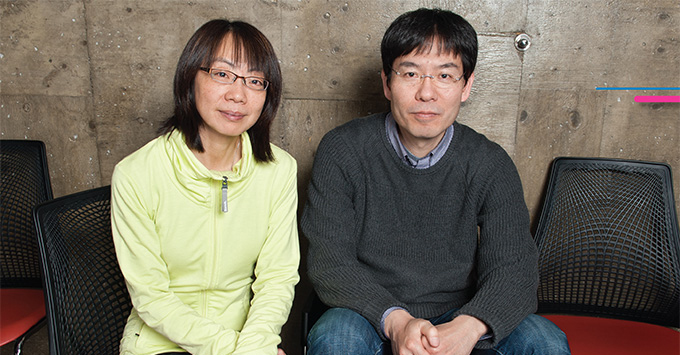

Imagine this scenario: You push your chair back from your desk at work, stand, and walk down the hall, dodging swiftly to your right to avoid colliding with a colleague as you turn the corner on your way to the kitchen. As you pass her by, the scent of lavender reminds you of your grandmother humming as she spritzed on the lavender-scented perfume she wore every day.
For most of us, it’s an unremarkable scenario. But for neurobiologists Dr. Mei Zhen and Dr. Kenichi Okamoto, it’s a source of many unanswered questions. How do we walk for minutes, even hours, without stopping? How do we change direction to avoid an obstacle in our path? How do we remember smells, images, sounds, words? The brain co-ordinates these and a myriad of other functions that make our complex physical and emotional lives possible. But how it does so is one of the great mysteries in biological science.
“The brain’s ability to sense its environment and direct movement is fundamental to every life form,” says Dr. Zhen, a senior investigator at LTRI. “Our goal is to understand how the brain does this, and to identify genes and cells that are involved in this process.”
A model system
Dr. Zhen explores these questions using C. elegans (roundworms), transparent, microscopic creatures that provide a nimble model for understanding the nervous system. The first multicellular organism to have its genome completely sequenced, it can be cultivated and housed cheaply and in large numbers — with approximately 10,000 worms to a single petri dish. Moreover, within three days after modifying a gene in the germline (sex cells) of a worm, it’s possible to see how its offspring perceive their environment and move differently.
“We are using these as a model to identify genetic codes that translate in all animals, including humans,” explains Dr. Zhen. “For example, what is the mechanism to sustain movement? Once this neuron is activated, the organism is able to sustain movement for a long time. Our goal is to build our knowledge base by identifying genes and understanding how they work in order to understand what causes neurological function or dysfunction in humans.”
Dr. Zhen’s discoveries have led to collaborations with colleagues to understand particular genes with an immediate clinical relevance. Drs. Jacques Michaud and Guy Rouleau at the Montreal Neurological Institute, the Université de Montréal and McGill University found a new mutation — a single amino acid altered in a single gene — in a patient who was suffering a wide range of neurodevelopmental symptoms for which there was no family history. They brought the mutation to Dr. Zhen, whose lab was among the first to discover the gene as part of a new family of membrane “channel” proteins that control a neuron’s ability to react to stimulation.
When Dr. Zhen tested the mutation in the C. elegans model, she found that the alteration of this amino acid increased the channel’s activity — and was responsible for all of the patient’s varied symptoms. Since then, more than 20 mutations in the gene have been identified and a new disease family that results from channel activity that is too low or too high has emerged, paving the way for new therapies that manipulate the channel’s activity to treat patients.
Tools of discovery
The brain is mysterious in part because it is so difficult to study, and the challenge to develop tools that will make future investigations possible is an urgent and complicated one — a first step that has the potential to unleash decades of discovery about how the brain functions when healthy and what goes wrong in various diseases.
Dr. Okamoto, an investigator at LTRI, is tackling this challenge head on using optogenetics, a pioneering technique heralded by the research journal Science as one of the “Breakthroughs of the Decade”. His unique optogenetic tools allow him to introduce neurons that have been genetically modified to contain a light-sensing protein into the brain of a living animal, and to activate or inactivate that target protein function “remotely,” using flashes of light. In his lab, Dr. Okamato has built a cutting-edge microscope equipped with infrared lasers, allowing him to locally manipulate specific proteins in the brains of mice and to “see” the functions of these proteins in order to investigate which are involved in memory and learning, and what role they may play in neurological disorders such as Alzheimer’s disease and autism.
In an ongoing collaboration, Drs. Zhen and Okamoto are joining forces to test and perfect optogenetics tools in the C. elegans model. The worm’s transparency allows them to manipulate part of the brain and to both see the light source through the living animal and precisely measure the effects in real-time. In effect, Drs. Zhen and Okamoto will be able to witness first-hand the way the worm’s behavior changes in response to the activation or inactivation of a particular gene or protein. This is the future of neuroscience, they say: to study the effects of specific manipulations in behaving animals, so we can improve quality of life and mobility for patients.
“The scientists whose fundamental discoveries made this possible were simply trying to study algae,” Dr. Zhen explains. “They wanted to know how those algae can sense light, and they had to invent and apply different techniques to address this. Their curiosity about these algae was the driving force, but out of that has come tools that we can use in many different ways to study the brain. It’s vital not to underestimate the vast amount of basic science research needed to fuel translational medicine.”